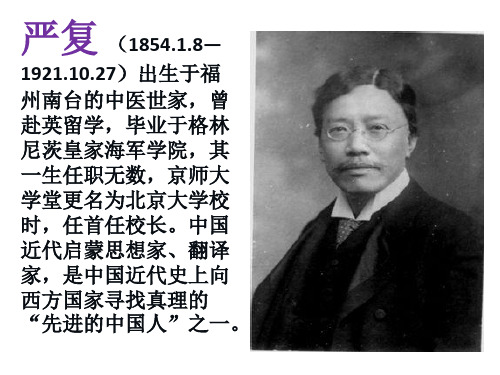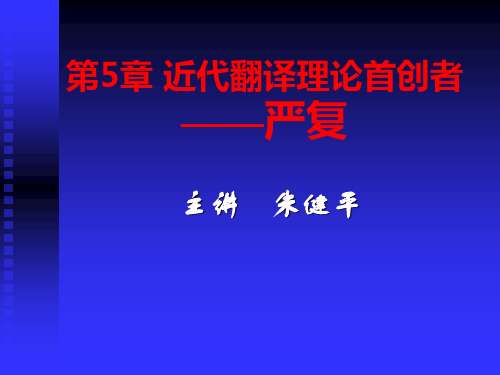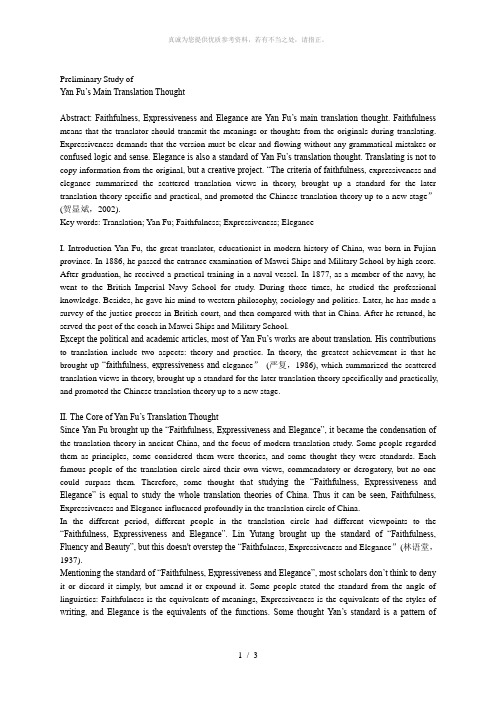翻译学导论严复
关于严复翻译原则的文献

关于严复翻译原则的文献摘要:一、引言二、严复的翻译原则1.信、达、雅2.直译与意译的平衡3.保持原文风格三、严复翻译原则的实践与影响1.翻译实践2.对后世翻译工作的影响四、结论正文:严复是一位清朝末年的著名翻译家,他的翻译原则对我国翻译事业产生了深远的影响。
本文将对严复的翻译原则进行探讨。
严复提出翻译原则为“信、达、雅”。
首先,“信”是指翻译要忠实于原文,准确传达原文的信息。
其次,“达”是指翻译要通顺、易懂,让读者能够顺畅地理解原文的意思。
最后,“雅”是指翻译要优美、文雅,保持原文的风格。
这一原则为后来的翻译工作者提供了指导。
在翻译实践中,严复力求在直译与意译之间找到平衡。
直译是指按照原文的形式和意义进行翻译,而意译则是更注重传达原文的意义,适当牺牲原文的形式。
严复认为,过于追求直译会导致译文生硬、不自然,而过于意译则可能使原文失去原有的韵味。
因此,在翻译过程中,严复努力在直译与意译之间寻求最佳方案。
此外,严复强调在翻译过程中要保留原文的风格。
他认为,每部作品都有其独特的风格,翻译时应尽量保持这种风格,使读者能够在阅读译文时感受到原文的魅力。
为此,严复在翻译时注意选用恰当的语言和表达方式,使译文既忠实于原文,又能体现原文的风格。
严复的翻译原则在实践中得到了很好的体现,他的译作具有很高的艺术价值。
同时,严复的翻译原则对后世翻译工作产生了深远的影响。
许多翻译工作者都以严复的翻译原则为指导,努力提高自己的翻译水平。
总之,严复的翻译原则具有很高的指导意义。
他的“信、达、雅”翻译原则为后来的翻译工作者提供了准则,他的直译与意译平衡观念以及保留原文风格的要求,使他的译作具有独特的艺术价值。
严复翻译理论

主要成就
• 严复生活于世纪之交,当时的中国 正处于从旧到新的转变过程中。他早 期作品偏重意译,略亏于信,尤其是 《天演论》,《天演论》题曰达旨,不 云笔译,取便发挥,实非正法。”
• 此时,他通过序言和大量的按语来阐 发自己的见解,并结合中国当时的实际 情况,把原书的理论改造成中国人可以 用来反封建、反侵略的进步学说。
• 严复中期的译品具有较强的目的性和针对性, 对拟议著作细心研究,在译述时,能写出非 凡的译例言和序跋,旁征博引,对原著多所 阐释。如《原富》《群学肄言》《社会同诠》 《名学浅说》。
• 晚期译作更为随便,有作品《中国教育译》 《支那教案论》《欧战源起》。
天演论
(一)背景
在甲午战争中,清军接连失败的刺激 下,以“公车上书”为开端的救亡运动迅速 开展,严复也积极投身其中。1895年2-5月, 严复先后在天津《直报》发表《论世变之亟》 《原强》《辟寒》《救亡决论》等一批重要 文章。在这些文章中,他比较系统的介绍了 中西社会的差异,分析了西方列强 的全方位 优势以及中国落后挨打的原因,提出了“鼓 民力、开民智、新民德”的应变策略。特别 是他所译述的《天演论》产生巨大的影响。
信达雅
“信” (faithfulness),是指忠实原文的 思想内容。 “达”(expressiveness)指译文通顺流畅。 “雅”(elegance)文字古雅。
Ps:这里严复所说的“雅”是指“汉以前的 字法句法”。严复是在使用文言文的时代从 事翻译,其所译原著多为英国维多利亚时期 的以文风典雅著称的作品。
人物评价
• 严复于中学西学皆我国第一流人物 -------梁启超
• 严复是近代中国第一个系统介绍西方文化的启 蒙思想家,十九世纪末传播西方政治学说的理 论家,传播西学的著名翻译家。 ———陈九如 毛泽东曾称赞他是“中国共产党出世以前向西 方寻找真理的一派人物”之一。
第10讲 近代翻译理论首创者严复

严复不仅是一位著名翻译家,也是一位 翻译理论家,他在翻译理论上提出的信、 达、雅三条翻译标准,对我国近代、现 代以至当代的翻译活动都具有深远的影 响。
1、严复生平
严复,字几道,字又陵,福建侯官(今福州)人。 从小受过良好教育,14岁考入福州船政学堂; 1877年赴英深造,不仅学习海军知识,还广泛接触 英国社会,积极吸收当时先进的资产阶级哲学、经 济学、政治学等西方文化知识; 1879年回国,到福州船政学堂任教; 1880年被李鸿章调任天津北洋水师学堂总教习; 1890年任学堂会办(副校长); 1900年升任总办(校长); 1895年中国在甲午战争中惨败,对他刺激很大,决 心致力翻译,以开启民智,救国图存;
原文: The native grasses and weeds, the scattered patches of gorse, contended with one another for the possession of the scanty surface soil; they fought against the droughts of summer, the frosts of winter, and the furious gales which swept, with unbroken force, now from the Atlantic, and now from the North Sea, at all times of the year;
严复译文: 计惟有天造 草昧,人功 未施,其借 征人境者, 不过几处荒 坟,散见坡 陀起伏间。 而灌木丛林, 蒙茸山麓, 未经删治如 今者,则无 疑也。
中国翻译家的翻译理论

严复严复是中国近代翻译史上学贯中西、划时代意义的翻译家,也是我国首创完整翻译标准的先驱者。
严复吸收了中国古代佛经翻译思想的精髓,并结合自己的翻译实践经验,在《天演论》译例言里鲜明地提出了“信、达、雅”的翻译原则和标准。
“信”(faithfulness)是指忠实准确地传达原文的内容;“达”(expressiveness)指译文通顺流畅;“雅”(elegance)可解为译文有文才,文字典雅。
这条著名的“三字经”对后世的翻译理论和实践的影响很大,20世纪的中国译者几乎没有不受这三个字影响的。
鲁迅在中国翻译史上,鲁迅曾做出了巨大的贡献.他提出的一些翻译观点极大地推动了中国的翻译研究.鲁迅翻译观的变化,从早期跟随晚清风尚以意译为主,到后期追求直译、反对归化.鲁迅的翻译思想主要是围绕"信"和"顺"问题展开的.他"宁信而不顺"的硬译观在我国文坛上曾经引发过极大的争议,其译文也因为生涩难懂而遭到攻击.然而,鲁迅翻译思想中的"信"与"不顺"体现了近代中国翻译活动救亡图存的根本目的,代表了文化转型时期中国翻译的发展方向,同时也为后人提供了探索和研究的起点.鲁迅先生说过:凡是翻译,必须兼顾两面,一则当然力求其易解,一则是保存着原作的丰姿。
从实质上来讲,就是要使原文的内容、风格、笔锋、韵味在译文中得以再现。
翻译涉及原语(source language)与译语(target language) 两种语言及其文化背景等各方面的知识,有时非常复杂。
所以,译者要想收到理想的翻译效果,常常需要字斟句酌,反复推敲,仅仅懂得一些基本技巧知识是不够的,必须广泛涉猎不同文化间的差异,必须在两种语言上下工夫,乃至独具匠心。
“五四”运动以后,中国历史进入了现代,翻译的重要性远迈前古。
中国新文学的兴起同翻译是分不开的。
第一个重视翻译并大力加以倡导的人是鲁迅。
翻译理论(1) 严复及其翻译理论

二、隋-唐-宋时期
从隋代(公元五九0年)到唐代,这 段时间是我国翻译事业高度发达时期。
代表人物:彦琮(俗姓李,赵郡柏人) 译经史上第一位中国僧人。
提出了作好佛经翻译的八项条件: 1)诚心受法,志愿益人,不惮久时(诚心热爱佛法, 立志帮助别人,不怕费时长久); 2)将践觉场,先牢戒足,不染讥恶(品行端正,忠实 可信,不惹旁人讥疑); 3)荃晓三藏,义贯两乘,不苦闇滞(博览经典,通达 义旨。不存在暗昧疑难的问题); 4)旁涉坟史,工缀典词,不过鲁拙(涉猎中国经史, 兼擅文学,不要过于疏拙); 5)襟抱平恕。器量虚融,不好专执(度量宽和,虚心 求益,不可武断固执); 6)耽于道术,淡于名利,不欲高炫(深爱道术,淡于 名利,不想出风头); 7)要识梵言,乃闲正译,不坠彼学(精通梵文,熟悉 正确的翻译方法,不失梵文所载的义理); 8)薄阅苍雅,粗谙篆隶。不昧此文(兼通中训诂之学, 不使译本文字欠准确)。
五、新中国成立至今
一九四九年,随着新中国的成立, 翻译事业也得到了解放。 代表人物: 曹靖华(1897—1987), 俄苏文学翻译家、散文作家、 北京大学教授
梁实秋(1902--1987), 著名学者、翻译家、散文家,现 代中国文坛巨匠,北京人。 强调“信”“顺”统一, 主张以句译为基础的直译, 反对“转译”,既对原文作者负责, 也对译文读者负责。
秦符时代;代表人物:释道安,鸠摩罗什
主要活动:佛经翻译 翻译特点: 释道安主张词对词、句对句(word for word, line for line)的直译 鸠摩罗什主张意译,纠正了过去音译的弱点,提倡 译者署名,以示负责。如《金刚经》、《法华经》、 《十二门论》、《中观论》、《维摩经》等。其译文神 情并茂、妙趣盎然,堪称当时的上乘之译作。 南北朝时期,梁武帝特聘印度佛教学者真谛 (Paramartha,499-569)到中国来翻译佛经。真谛 在华期间共翻译了四十九部经书,其中尤以《摄大乘论》 的翻译响誉华夏,对中国佛教思想影响较大。
翻译学导论严复

Preliminary Study ofYan Fu’s Main Translation ThoughtAbstract: Faithfulness, Expressiveness and Elegance are Yan Fu’s main translation thought. Faithfulness means that the translator should transmit the meanings or thoughts from the originals during translating. Expressiveness demands that the version must be clear and flowing without any grammatical mistakes or confused logic and sense. Elegance is also a standard of Yan Fu’s translation thought. Translating is not to copy information from the original, but a creative project. “The criteria of faithfulness, expressiveness and elegance summarized the scattered translation views in theory, brought up a standard for the later translation theory specific and practical, and promoted the Chinese translation theory up to a new stage”(贺显斌,2002).Key words: Translation; Yan Fu; Faithfulness; Expressiveness; EleganceI. Introduction Yan Fu, the great translator, educationist in modern history of China, was born in Fujian province. In 1886, he passed the entrance examination of Mawei Ships and Military School by high score. After graduation, he received a practical training in a naval vessel. In 1877, as a member of the navy, he went to the British Imperial Navy School for study. During those times, he studied the professional knowledge. Besides, he gave his mind to western philosophy, sociology and politics. Later, he has made a survey of the justice process in British court, and then compared with that in China. After he retuned, he served the post of the coach in Mawei Ships and Military School.Except the political and academic articles, most of Yan Fu’s works are about translation. His contributions to translation include two aspects: theory and practice. In theory, the greatest achievement is that he brought u p “faithfulness, expressiveness and elegance”(严复,1986), which summarized the scattered translation views in theory, brought up a standard for the later translation theory specifically and practically, and promoted the Chinese translation theory up to a new stage.II. The Core of Yan Fu’s Translation ThoughtSince Yan Fu brought up the “Faithfulness, Expressiveness and Elegance”, it became the condensation of the translation theory in ancient China, and the focus of modern translation study. Some people regarded them as principles, some considered them were theories, and some thought they were standards. Each famous people of the translation circle aired their own views, commendatory or derogatory, but no one could surpass them. Therefore, some thought tha t studying the “Faithfulness, Expressiveness and Elegance” is equal to study the whole translation theories of China. Thus it can be seen, Faithfulness, Expressiveness and Elegance influenced profoundly in the translation circle of China.In the different period, different people in the translation circle had different viewpoints to the “Faithfulness, Expressiveness and Elegance”. Lin Yutang brought up the standard of “Faithfulness, Fluency and Beauty”, but this doesn't overstep the “Faithf ulness, Expressiveness and Elegance”(林语堂,1937).Mentioning the standard of “Faithfulness, Expressiveness and Elegance”, most scholars don’t think to deny it or discard it simply, but amend it or expound it. Some people stated the standard from the angle of linguistics: Faithfulness is the equivalents of meanings, Expressiveness is the equivalents of the styles of writing, and Elegance is the equivalents of the functions. Some thought Yan’s standard is a pattern oftranslation. It promotes esthetics of phraseology to the peak.Faithfulness means that the translator should transmit the meanings or thoughts from the originals during translating. In other words, the translation should reflect the whole information accurately and completely. The information maybe include the meanings and thoughts of the author, the culture and customs of a country, the life-style and the way of thinking of the people and so on.Then, how to achieve it during translating? First of all, comprehensive quality of the translator is very important. That is, he should learn the culture and customs of other countries directly or indirectly. One of the ways may be to read a lot of books, materials or works on many subjects, to study in many fields, such as literature, history, philosophy, and astronomy, geography. Second, he should learn the culture and customs of other countries directly or indirectly. According to Yan Fu, to learn the western culture and custom, the best way is to study the foreign language, then read the western books, observe and learn from the western life(严复,1986). To achieve this, one cannot only learn the western culture realistically, but also read books unlimitedly.Therefore, to achieve Faithfulness during translating, one may learn the foreign culture by learning its language firs t. Then receive more knowledge indirectly. Besides, it’s also an effective way to live abroad for some periods. After being a member of the society of country, you will learn much more things at there gradually.According to Yan Fu, Expressiveness in translating means the translation should be logical. If the translation is just a collection of all the information from the originals, the readers couldn’t understand it. Of course, as a translator, to make readers catching the general idea of the translation is the basic work. However, how to achieve Expressiveness when translating? It all depends. Expressiveness dose not mean that translator will use the same, single way to treat different kinds of originals. That is, different originals will be treated in different ways. For example, literature will be translated in literature languages, political works will be stated in some political terms, while when you translating something about medical, technology, law, the related terminologies should be used accurately and properly, that is, if the scientific technicalities are used in a poem improperly, readers will be not understand it correctly. Therefore, to achieve Expressiveness, one should learn the characters of different kinds of types of writing and choose the proper way to express it.Elegance is also a standard of Yan’s translation thought. Translating is not the information copied from the originals, but a creative project. A perfect translation is not only faithful and expressive, but also elegant. Elegance is the higher request of language. That is, the translation should be elegant.III. Conclusion Faithfulness, Expressiveness and Elegance formed a whole translation thought. But they play different roles in it. Some people thought, the effective Faithfulness is the preliminary level of Expressiveness, and Expressiveness is the higher level of Faithfulness, while the Expressiveness is the highest level of Faithfulness and Expressiveness.In a word, Yan Fu’s translation theory of “Faithfulness, Expressiveness and Elegance” influenced the translation circle deeply. A lot of scholars study it, and think it is an effective standard. The criteria of faithfulness, expressiveness and elegance summarized the scattered translation views in theory, brought up a standard for the later translation theory specific and practical, and promoted the Chinese translation theory up to a new stage.Bibliography贺显斌,《严复翻译思想补遗》。
严复的翻译理论
研究严复的翻译的著述,可能已远远多于严复的译作本身了。
严复于译事的贡献涉及了理论和实践两个方面。
在翻译理论方面,严复最伟大的贡献在于,在《天演论·译例言》中,将三国时支谦《法句经序》中提到过的“信”、“达”、“雅”三字,按译事的内在规律排列组合,明确地将其作为“译事楷模”,成为“我国译界倡导系统而完整翻译标准的先驱”。
“信达雅”说“客观上起到继往开来的作用,一方面集汉唐译经论说之大成,另一方面开近世翻译学说之先河(罗新璋,1984:6)。
”“信达雅”标准的提出,把我国历史上零散的翻译观点从理论上加以扼要、中肯、鲜明、概括的综合,为后世从事翻译的人提出了明确可信、具体切实的翻译标准,使我国的翻译理论上升到一个新的阶段(高惠群、乌传衮,1992:85)。
“信达雅”是中国传统翻译思想的纲领,也是严复翻译理论的核心,但并非严复翻译思想的全部。
比如,在《20世纪中国翻译思想史》的“严复的翻译思想”一节中,除了这著名的翻译“三字经”外,王秉钦教授(2004:52-72)还提到,严复是作为启蒙思想家的翻译家;引进近代西方先进科学思想,作为改造中国人世界观的理论基础和思想启蒙的武器,从根本上彻底改造中国,是严复翻译思想的灵魂;“非正法”的宏观翻译手段,即根据中国社会现状和国人的需要,有选择、有取舍地摄取西方文化思想,且附有精辟的按语,是严复翻译思想的重要组成部分。
严复的翻译理论不仅反映在他为多种译作所写的“译例言”、“译凡例”或者“译序”中,也体现在他的部分书信和有关翻译的几篇专文中。
除了“信达雅”翻译标准和刚刚提到的内容以外,严复的翻译思想至少还应包括他对可译性、翻译版权和翻译管理等方面的认识。
论严复_信_达_雅_翻译思想
收稿日期:2005-01-18 作者简介:冯立新(1970-),男,湖北大冶人,华南农业大学外国语学院讲师,主要研究方向为语言学与翻译.论严复“信、达、雅”翻译思想冯立新(华南农业大学外国语学院,广东广州510642)摘 要:严复认为,“译事三难:信、达、雅”。
“信”是翻译之前提和基础,“达”是翻译之目的,“雅”是翻译之语体选择。
在这一百多年时间里,对“信、达、雅”的阐释可谓是仁者见仁,智者见智,对其评判也是毁誉参半,莫衷一是。
同时,在翻译实践中严复并没有严格遵守信、达、雅的翻译标准,这主要源于其西学救亡的翻译动机和当时官僚士大夫对西学的排斥。
关键词:严复;信、达、雅;翻译标准中图分类号:H059 文献标识码:A 文章编号:1672-0202(2005)02-0131-04 严复(1854~1921),福建侯官(今福州)人,字几道。
1866年,他考入福州船政学堂,1877年被派往英国留学,学习海军。
留学期间,他广泛涉猎了亚当・斯密、约翰・穆勒、孟德斯鸠、达尔文、赫胥黎等人的经济、法律理论、进化论和逻辑学等新学说新思想,参观过英国议会、法院等制度设施,深入地了解了西方的政治、经济和社会。
严复所处时代正是中国处于生死存亡的时期,启蒙与救亡是中国近代两大主题。
为挽救危亡的中国,他大量翻译了西方著作。
在中国思想界产生了极大影响,被人誉为“译界泰斗”[1]和“能熔中西为一冶”的第一人[2]1561。
他较为系统地提出了“信、达、雅”之翻译标准,对中国翻译思想和翻译理论产生了较大影响。
一1895年,严复开始翻译赫胥黎的著作《进化论与伦理学》,并取名《天演论》。
他在《天演论》的“译例言”中说:“译事三难:信、达、雅”。
他引用孔子的话,“修辞立诚”,“辞达而已”,“言之无文,行之不远”,并指出,信、达、雅“乃文章正轨,亦即为译事楷模。
故信、达而外,求其尔雅”[2]1322。
此翻译思想一出,即备受推崇,甚至被奉作翻译的“金科玉律”。
严复的翻译理论
“信达雅”说“客观上起到继往开来的作用,一方面集汉唐译经论说之大成,另一方面开近世翻译学说之先河(罗新璋,1984:6)。”“信达雅”标准的提出,把我国历史上零散的翻译观点从理论上加以扼要、中肯、鲜明、概括的综合,为后世从事翻译的人提出了明确可信、具体切实的翻译标准,使我国的翻译理论上升到一个新的阶段(高惠群、乌传衮,1992:85)。
1900年2月,《原富》全部译完,只差序言、目录、例言、作者传等没有完成。严复写信给张元济,首次提出翻译版税之事;他还以郭隗千金市骨招揽人才的故事,说明实行版权保护的必要性:
……仆尚有鄙情奉商左右者,则以谓此稿既经公学弍千金购印,则成书
后自为公学之产,销售利益应悉公学得之;但念译者颇费苦心,不知他日出售,能否于书价之中坐抽几分,以为著书者永远之利益。此于鄙人所关尚浅,而于后此译人所劝者大,亦郭隗千金市骨之意也。”(王栻,1986:538)
研究严复的翻译的著述,可能已远远多于严复的译作本身了。严复于译事的贡献涉及了理论和实践两个方面。在翻译理论方面,严复最伟大的贡献在于,在《天演论·译例言》中,将三国时支谦《法句经序》中提到过的“信”、“达”、“雅”三字,按译事的内在规律排列组合,明确地将其作为“译事楷模”,成为“我国译界倡导系统而完整翻译标准的先驱”。
严复一生译过十余本书,其中八种被商务印书馆列为“严译名著”,它们对晚清的社会变革产生了很大的影响。但令人难以置信的是,严复其实是对翻译不信任的(王宏志,1999:105),他在多处著述中流露出了这个观点。
1902年,严复给《外交报》写信,谈到西学教育宜用之语言时,严复说:
吾闻学术之事,必求之初地而后得其真ห้องสมุดไป่ตู้自奋耳目心思之力,以得之于两间之见象者,上之上者也。其次则乞灵于简策之所流传,师友之所授业。然是二者,必资之其本用之文字无疑也。最下乃求之于翻译,其隔尘弥多,其去真滋远。”(王栻,1986:561)
严复翻译理论
翻译有三大难事分别是:“信”是指表达原文意义的准确性,译文应忠实于原文思想;“达”指对原文思想内容和深层含义的表达,使译文读者能够读懂、理解;“雅”是忠于原文的文体特征,包括形象、语气、口吻、氛围等,总之要运用读者最为乐意接受的语言风格。
忠实于原著本就不容易了,但是仅仅追求原文意义的准确性而忽略了原文的思想内容和深层含义,那么即便是译出来了也相当于没有翻译,并未达到“达”的标准。
自从海外交通开放以来,翻译人才随处可见,不过任取其一翻译的作品来看,能够将“信”与“达”两者结合的很好的却很少。
归结其原因的话其一应该是他们大多对于原著只是蜻蜓点水,粗略的浏览,并且偏离了原著,第三点则是对原文缺乏深入研究的人甚少。
现在这本《天演论》所阐述的都是近五十年来西方科学界崭新的研究成果,而且是作者晚年出版的著作。
我的译文着重在解释他的理论精髓。
所以词与词句与句之间,时常有我自己所附带的感受而进行修正补充。
我并没有计较于逐字逐句之间,(因为我觉得)只要译文思想意义不背离原文那么译文可不必受原文拘束。
换句话说,只要符合原文旨意,那么译文不一定要跟随原著而译,以便译者有发挥的空间,但是这却是不是翻译的正确方法。
鸠摩罗什法师说过:“拘泥于形迹,那么不能够健全的发展。
”将来翻译者会更多,千万不要搬用我的做法。
- 1、下载文档前请自行甄别文档内容的完整性,平台不提供额外的编辑、内容补充、找答案等附加服务。
- 2、"仅部分预览"的文档,不可在线预览部分如存在完整性等问题,可反馈申请退款(可完整预览的文档不适用该条件!)。
- 3、如文档侵犯您的权益,请联系客服反馈,我们会尽快为您处理(人工客服工作时间:9:00-18:30)。
Preliminary Study ofYan Fu’s Main Translation ThoughtAbstract: Faithfulness, Expressiveness and Elegance are Yan Fu’s main translation thought. Faithfulness means that the translator should transmit the meanings or thoughts from the originals during translating. Expressiveness demands that the version must be clear and flowing without any grammatical mistakes or confused logic and sense. Elegance is also a standard of Yan Fu’s translation thought. Translating is not to copy information from the original, but a creative project. “The criteria of faithfulness, expressiveness and elegance summarized the scattered translation views in theory, brought up a standard for the later translation theory specific and practical, and promoted the Chinese translation theory up to a new stage”(贺显斌,2002).Key words: Translation; Yan Fu; Faithfulness; Expressiveness; EleganceI. Introduction Yan Fu, the great translator, educationist in modern history of China, was born in Fujian province. In 1886, he passed the entrance examination of Mawei Ships and Military School by high score. After graduation, he received a practical training in a naval vessel. In 1877, as a member of the navy, he went to the British Imperial Navy School for study. During those times, he studied the professional knowledge. Besides, he gave his mind to western philosophy, sociology and politics. Later, he has made a survey of the justice process in British court, and then compared with that in China. After he retuned, he served the post of the coach in Mawei Ships and Military School.Except the political and academic articles, most of Yan Fu’s works are about translation. His contributions to translation include two aspects: theory and practice. In theory, the greatest achievement is that he brought up “faithfulness, expressi veness and elegance”(严复,1986), which summarized the scattered translation views in theory, brought up a standard for the later translation theory specifically and practically, and promoted the Chinese translation theory up to a new stage.II. The Core of Yan Fu’s Translation ThoughtSince Yan Fu brought up the “Faithfulness, Expressiveness and Elegance”, it became the condensation of the translation theory in ancient China, and the focus of modern translation study. Some people regarded them as principles, some considered them were theories, and some thought they were standards. Each famous people of the translation circle aired their own views, commendatory or derogatory, but no one could surpass them. Therefore, some thought that studying the “Faithfulness, Expressiveness and Elegance” is equal to study the whole translation theories of China. Thus it can be seen, Faithfulness, Expressiveness and Elegance influenced profoundly in the translation circle of China.In the different period, different people in the translation circle had different viewpoints to the “Faithfulness, Expressiveness and Elegance”. Lin Yutang brought up the standard of “Faithfulness, Fluency and Beauty”, but this doesn't overstep the “Faithf ulness, Expressiveness and Elegance”(林语堂,1937).Mentioning the standard of “Faithfulness, Expressiveness and Elegance”, most scholars don’t think to deny it or discard it simply, but amend it or expound it. Some people stated the standard from the angle of linguistics: Faithfulness is the equivalents of meanings, Expressiveness is theequivalents of the styles of writing, and Elegance is the equivalents of the functions. Some thought Yan’s standard is a pattern of translation. It promotes esthetics of phraseology to the peak. Faithfulness means that the translator should transmit the meanings or thoughts from the originals during translating. In other words, the translation should reflect the whole information accurately and completely. The information maybe include the meanings and thoughts of the author, the culture and customs of a country, the life-style and the way of thinking of the people and so on. Then, how to achieve it during translating? First of all, comprehensive quality of the translator is very important. That is, he should learn the culture and customs of other countries directly or indirectly. One of the ways may be to read a lot of books, materials or works on many subjects, to study in many fields, such as literature, history, philosophy, and astronomy, geography. Second, he should learn the culture and customs of other countries directly or indirectly. According to Yan Fu, to learn the western culture and custom, the best way is to study the foreign language, then read the western books, observe and learn from the western life(严复,1986). To achieve this, one cannot only learn the western culture realistically, but also read books unlimitedly.Therefore, to achieve Faithfulness during translating, one may learn the foreign culture by learning its language first. Then receive more knowledge indirectly. Besides, it’s also an effective way to live abroad for some periods. After being a member of the society of country, you will learn much more things at there gradually.According to Yan Fu, Expressiveness in translating means the translation should be logical. If the translation is just a collection of all the information from the originals, the readers couldn’t understand it. Of course, as a translator, to make readers catching the general idea of the translation is the basic work.However, how to achieve Expressiveness when translating? It all depends. Expressiveness dose not mean that translator will use the same, single way to treat different kinds of originals. That is, different originals will be treated in different ways. For example, literature will be translated in literature languages, political works will be stated in some political terms, while when you translating something about medical, technology, law, the related terminologies should be used accurately and properly, that is, if the scientific technicalities are used in a poem improperly, readers will be not understand it correctly. Therefore, to achieve Expressiveness, one should learn the characters of different kinds of types of writing and choose the proper way to express it. Elegance is also a standard of Yan’s translation thought. Translating is not the information copied from the originals, but a creative project. A perfect translation is not only faithful and expressive, but also elegant. Elegance is the higher request of language. That is, the translation should be elegant.III. Conclusion Faithfulness, Expressiveness and Elegance formed a whole translation thought. But they play different roles in it. Some people thought, the effective Faithfulness is the preliminary level of Expressiveness, and Expressiveness is the higher level of Faithfulness, while the Expressiveness is the highest level of Faithfulness and Expressiveness.In a word, Yan Fu’s translation theory of “Faithfulness, Expressiveness and Elegance” influenced the translation circle deeply. A lot of scholars study it, and think it is an effective standard. The criteria of faithfulness, expressiveness and elegance summarized the scattered translation views in theory, brought up a standard for the later translation theory specific and practical, and promoted the Chinese translation theory up to a new stage.Bibliography贺显斌,《严复翻译思想补遗》。
